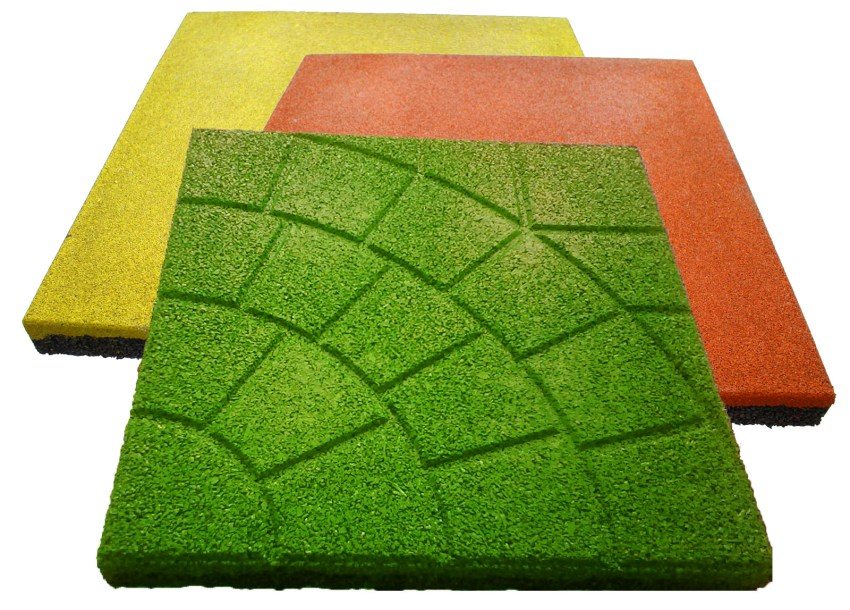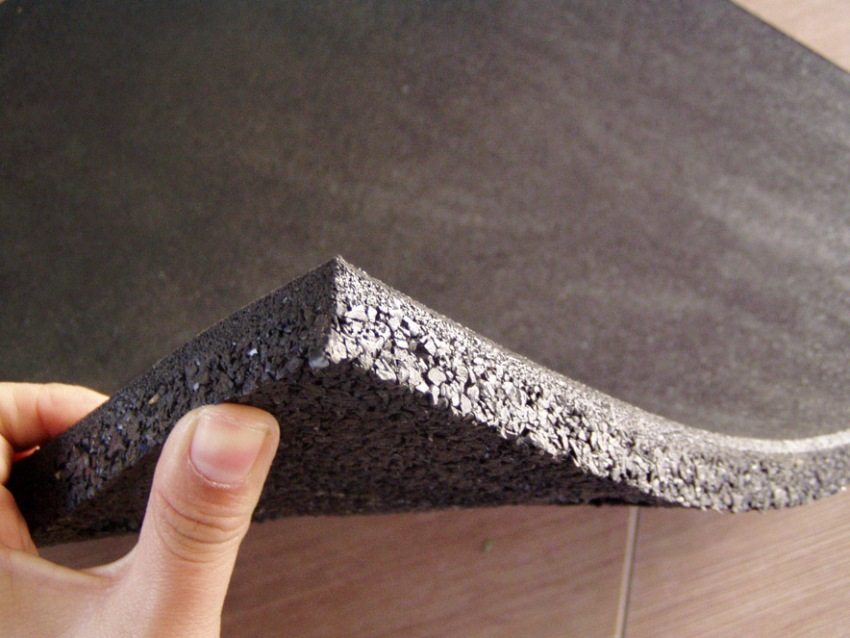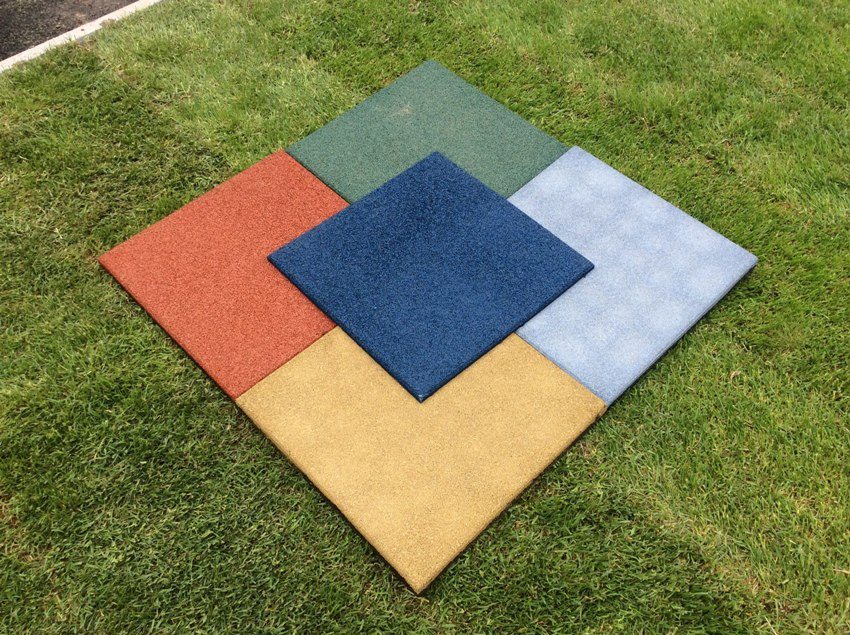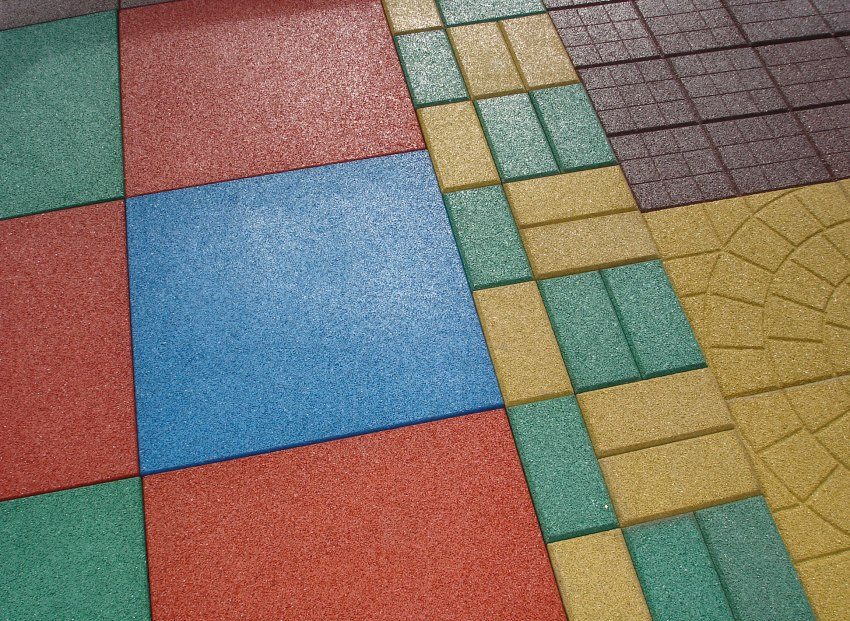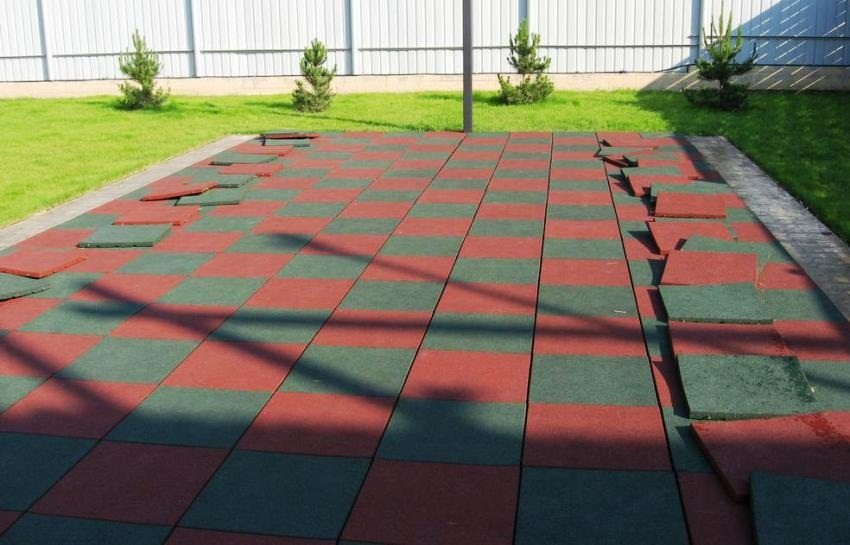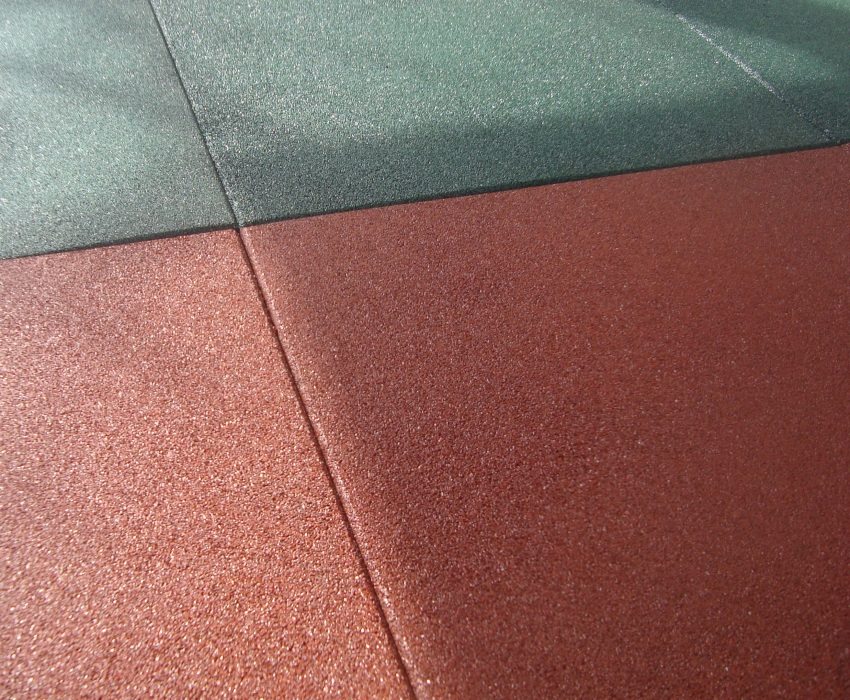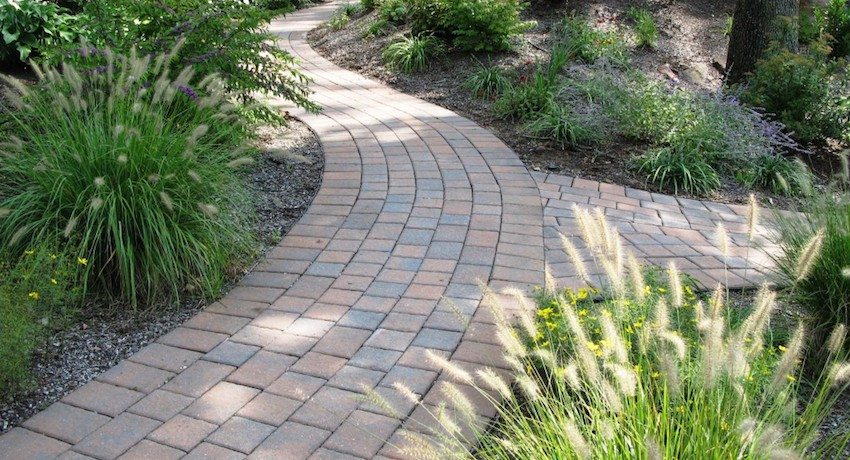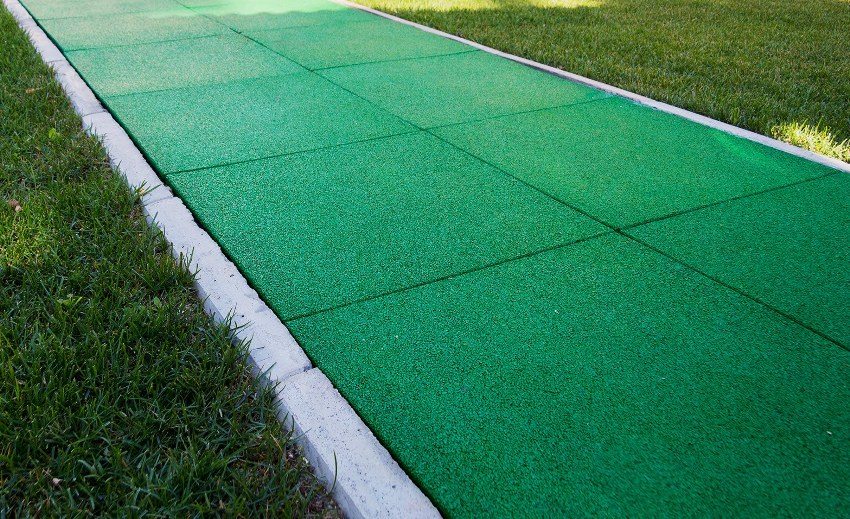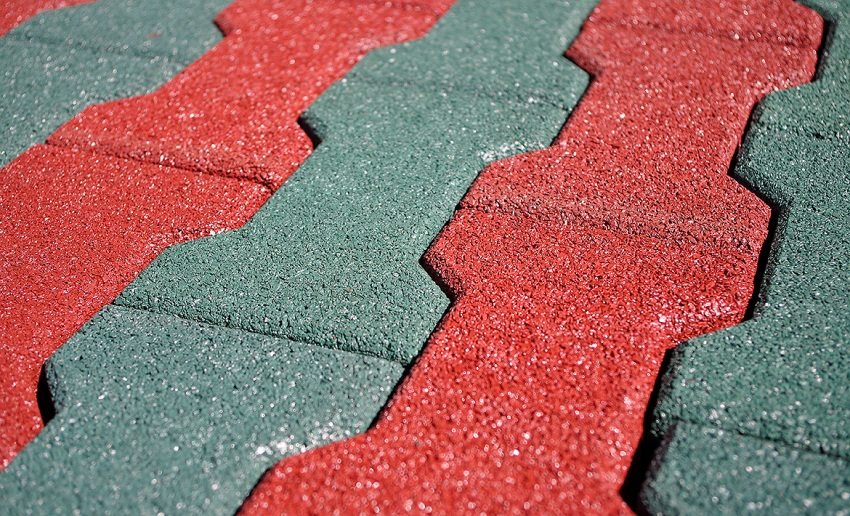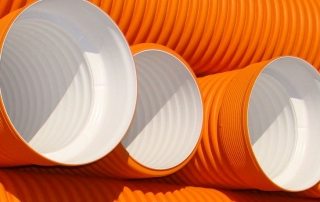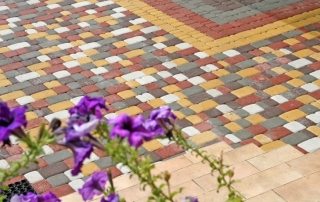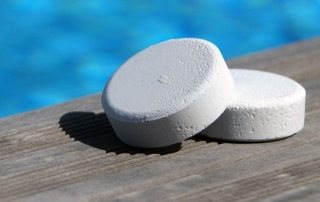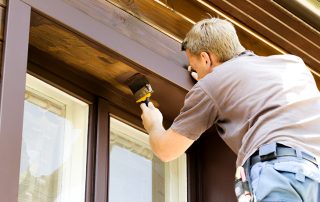The improvement of a summer cottage, in accordance with modern ideas about comfort and beauty, is a need for millions of people. Convenient and durable paths have not only a practical function, but are also an excellent decorative element that gives a complete look to the entire country landscape. You can cover the tracks with various materials. However, it is worth paying attention to the advantages of such material as rubber tiles for paths in the country: price, ease of installation, versatility in use and many others. The opinion of buyers confirms the advantages of rubber tiles, reviews can be easily found on the Internet.
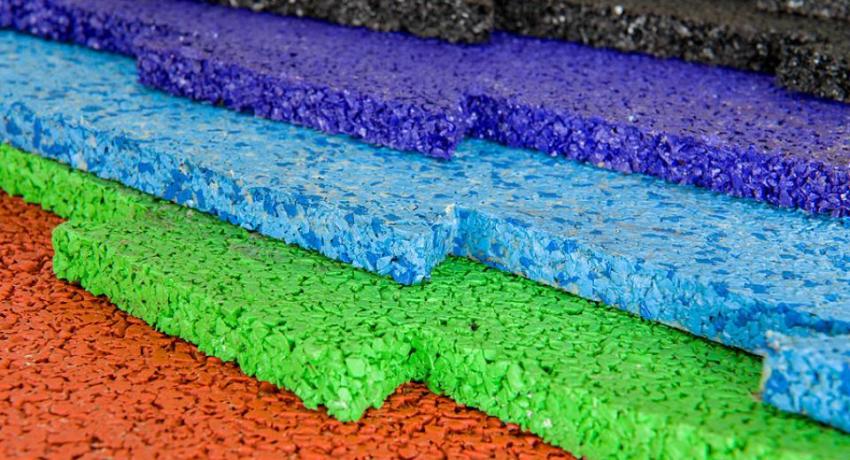
Thanks to the color pigments included in the composition, you can get completely different shades of rubber tiles
Content
Rubber tiles for paths in the country: price and comparative characteristics
From the name it is clear that this type of coating is made of rubber. However, this does not require setting up the production of special raw materials. The used car tires, after deep processing using a special technology, are used to make rubber tiles for the tracks in the country. The price of these products is quite high, despite the fact that secondary raw materials are used for their production.
It's all about the complexity of the technological process. On average, sellers ask for $ 15 to $ 25 for 1 m². For comparison, the average price of cement tiles is from 7.5 USD, and of plastic tiles from 7 USD.
The high cost pays off by the advantages that this type of pavement coating has. Unlike cement and plastic types, rubber track tiles:
- has a much lower weight: a product with dimensions of 330x330x22 mm weighs 3 kg versus 5 kg for a cement version of similar dimensions;
- absolutely non-slip, which cannot be said about any other material;
- does not accumulate water on its surface;
- is elastic, which guarantees no injury when falling, so using rubber tiles for playgrounds is a very good option;
- has more than 10-year service life, since it is not subject to destruction as a result of temperature changes. Rubber simply stretches and contracts without consequences for the structure of the material, which is very dangerous for ceramics and cement;
- the possibility of producing both permeable and waterproof types;
- very easy to fit into place even by people who do not have construction skills;
- does not break during transportation, so you can buy rubber paving slabs from a remote manufacturer and not worry that it will be damaged during transportation.
Like any other building material, there are several types of rubber tiles for paths in the country. Price is not the determining parameter here:
- Square tiles with dimensions from 330x330 to 500x500 mm. Its thickness can be from 10 to 40 mm. The surface of such a tile can be: simple, with patterns, with various textured patterns in the form of a grid, cobwebs and other ornaments.
- Paving stones from 20 to 40 mm thick. It can be of any shape. The most common products are: coils, waves, bricks. The surface of the paving stone can also have a different texture.
- Seamless rubber cover. Unlike tiles and paving stones are not piece goods. They are laid according to the technology of the flooded floor, that is, first a mixture of components is prepared, which is poured and leveled over the required area.
- Rubber curb for track construction.
Since rubber is a very paintable material, different types of crumb rubber paving slabs can have a wide range of colors. The product is manufactured from crumb, so the work surface has a matte grainy appearance. Popular colors: terracotta, green, blue, yellow, brown, orange, black.
Related article:
Paving slabs in the courtyard of a private house: photo compositions. Types of sidewalk tiles for the yard of a private house. Methods and styles of laying paving slabs. Photos of various styles, video.
The huge number of colors and textures of rubber tiles allows you to create garden paths with a unique design. Due to the simplicity of its installation, anyone can do it.
Useful advice! If you decided to equip the site yourself, then there is no better rubber tile for paths in the country. The price of such a coating is somewhat higher, but you can not doubt your abilities, since it is easier to lay it than all other types.
Types and styles of rubber tile tracks
Choosing the style for the tracks in your summer cottage should be in the same vein with the general concept of the entire space. If the design is dominated by straight lines and a strict classic style, then your choice should be stopped on square and rectangular types of tiles and paving stones with the obligatory use of borders. The color scheme can be varied, but bright colors should be avoided, as this does not match the classic image of the entire site.
If the garden is decorated in country style or in the style of "unity with nature", then you need to use natural natural tones. The shape and texture of the tiles should resemble natural materials such as stone, pebbles or wood. The shape of the tracks themselves can be with bends, differences in heights and with islands for flower bed.
Contemporary decor welcomes bright colors, additional accessories in the form of lamps or lamp posts. In this case, the paths can be either straight with curbs or curved. Rubber tiles are the most indispensable material for laying on track areas around pools and other summer cottages. You cannot slip on it even with wet feet. Tiles lined with circular shapes on the paths that surround country pondlooks very out of place.
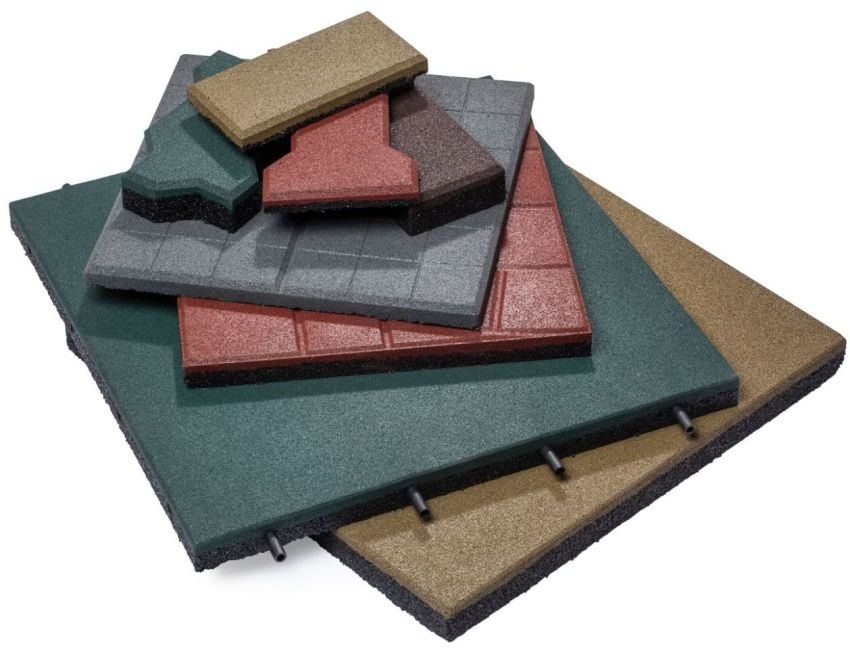
Some types of rubber tiles have special rods that provide a strong adhesion of products to each other
Useful advice! Rubber tiles are very suitable for covering playgrounds and sports facilities. Therefore, if on dacha there are swing, horizontal bars, bars or slides for children, then they must certainly be covered with such material. This will prevent injury to children.
Rubber tile laying technology and its operation
There are 2 ways of laying rubber paving slabs, differing in the base arrangement:
The first way is on the ground.This method is most suitable for a garden plot. Arrangement of the track in this way begins with the removal of the grass turf and the top layer of soil. The deepening should be from 250 to 300 mm. depth. The bottom is well tamped and a layer of crushed stone up to 100 mm is poured onto it. thick.
Then a layer of sand or a cement-sand mixture of 50-70 mm is laid on top of this. Everything is rammed again. Only then can the tiles be laid. If the path is planned with a border, then it must be installed in advance. For this method, tiles from 20 to 80 mm thick are suitable.
Useful advice! When laying tiles there is no need for a slope directly on the ground, since the water will go into the sand cushion. Tiles should be chosen with bushings inserted into the ends of the products. This design gives strength to the entire structure and will not allow the tiles to disperse over time.
The second way is on a solid foundation. Less thick products can also be used here. 20 mm will be enough. The base for the path can be asphalt, concrete, wooden floor. It is not permissible that the asphalt base has irregularities and cracks, therefore it must be treated with a primer. To do this, it is necessary to prepare it from a mixture of polyurethane glue and acetone, and then apply it to the entire surface of the asphalt.
The requirements for the concrete screed are less stringent. There may be minor chips and cracks on its surface. Such a surface must also be primed. After it dries, the tiles are glued with polyurethane glue. It can be applied to the tile surface with a roller or trowel.
Useful advice! When laying rubber tiles on a solid base, a slope of about 2 degrees must be provided. This will allow water to drain freely and not accumulate between the tiles.
Rubber tiles for paths in the country, the price of which is often higher than that of other types of coating, has a sufficiently high strength and immunity to temperature fluctuations. This circumstance makes it possible to avoid any special techniques during its operation. It is quite enough to rinse it out with a hose as it gets dirty.
Stubborn dirt can be removed with any detergent. In winter, ice can be chipped off the path with a non-sharp ice ax and removed with a shovel. Due to its elasticity, the ice easily falls off.
When deciding on an independent arrangement of sidewalks, country paths, covering areas near pools or ponds, you should pay attention to rubber paving slabs. This material is the easiest to lay, it has many colors and textures, which allows you to create an object in any style. If you follow all the simple instructions, the result will be pleasing for at least 10 years.
Rubber tile production video
